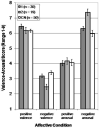Patterns of emotional experience in schizophrenia: differences in emotional response to visual stimuli are associated with clinical presentation and functional outcome
- PMID: 21330110
- PMCID: PMC3085645
- DOI: 10.1016/j.schres.2011.01.010
Patterns of emotional experience in schizophrenia: differences in emotional response to visual stimuli are associated with clinical presentation and functional outcome
Abstract
The current study examined whether patterns of emotional response are differentially associated with symptom presentation and functional outcome in individuals with schizophrenia. Participants included 49 outpatients with schizophrenia and 50 demographically matched controls. All participants rated their emotional response to 131 images from the International Affective Picture Systems (IAPS) library on both arousal and valence scales. Stimuli were split into categories of positive versus negatively valenced stimuli based on control subject ratings. Cluster analysis was used to assess whether there were reliably distinct patterns of emotional response within the patient sample. Follow-up discriminant function analysis indicated that these groups were adequately separated. Sixty percent of the individuals with schizophrenia rated valence and arousal similarly to healthy subjects, while 40% displayed an atypical profile. Schizophrenia sub-groups classified by these two emotional response styles significantly differed on measures of functional outcome, severity of negative symptoms, and self-reported anhedonia. Findings are discussed in relation to current theories of emotional experience in schizophrenia.
Copyright © 2011 Elsevier B.V. All rights reserved.
Conflict of interest statement
The authors have no conflicts of interest.
Figures





Similar articles
-
Heterogeneity of emotional experience in schizophrenia: Trait affect profiles predict clinical presentation and functional outcome.J Abnorm Psychol. 2020 Oct;129(7):760-767. doi: 10.1037/abn0000554. Epub 2020 Jun 25. J Abnorm Psychol. 2020. PMID: 32584084 Free PMC article.
-
What aspects of emotional functioning are impaired in schizophrenia?Schizophr Res. 2008 Jan;98(1-3):239-46. doi: 10.1016/j.schres.2007.06.025. Epub 2007 Aug 3. Schizophr Res. 2008. PMID: 17689054 Free PMC article.
-
Aberrantly flattened responsivity to emotional pictures in paranoid schizophrenia.Psychiatry Res. 2006 Aug 30;143(2-3):135-45. doi: 10.1016/j.psychres.2005.09.011. Epub 2006 Aug 1. Psychiatry Res. 2006. PMID: 16884781
-
Emotional Experience of People With Schizophrenia and People at Risk for Psychosis: A Meta-Analysis.JAMA Psychiatry. 2024 Jan 1;81(1):57-66. doi: 10.1001/jamapsychiatry.2023.3589. JAMA Psychiatry. 2024. PMID: 37755868 Free PMC article.
-
A review of emotion deficits in schizophrenia.Dialogues Clin Neurosci. 2006;8(1):59-70. doi: 10.31887/DCNS.2006.8.1/ftremeau. Dialogues Clin Neurosci. 2006. PMID: 16640115 Free PMC article. Review.
Cited by
-
Cognition-emotion interactions are modulated by working memory capacity in individuals with schizophrenia.Schizophr Res. 2012 Nov;141(2-3):257-61. doi: 10.1016/j.schres.2012.08.010. Epub 2012 Sep 8. Schizophr Res. 2012. PMID: 22968207 Free PMC article.
-
THE POSITIVITY OFFSET THEORY OF ANHEDONIA IN SCHIZOPHRENIA.Clin Psychol Sci. 2017 Mar;5(2):226-238. doi: 10.1177/2167702616674989. Epub 2017 Mar 10. Clin Psychol Sci. 2017. PMID: 28497008 Free PMC article.
-
Emotional response in schizophrenia to the "36 questions that lead to love": Predicted and experienced emotions regarding a live social interaction.PLoS One. 2019 Feb 27;14(2):e0212069. doi: 10.1371/journal.pone.0212069. eCollection 2019. PLoS One. 2019. PMID: 30811436 Free PMC article.
-
A common NTRK2 variant is associated with emotional arousal and brain white-matter integrity in healthy young subjects.Transl Psychiatry. 2016 Mar 15;6(3):e758. doi: 10.1038/tp.2016.20. Transl Psychiatry. 2016. PMID: 26978740 Free PMC article.
-
Deconstructing negative symptoms of schizophrenia: avolition-apathy and diminished expression clusters predict clinical presentation and functional outcome.J Psychiatr Res. 2013 Jun;47(6):783-90. doi: 10.1016/j.jpsychires.2013.01.015. Epub 2013 Feb 27. J Psychiatr Res. 2013. PMID: 23453820 Free PMC article.
References
-
- Aghevli MA, Blanchard JJ, Horan WP. The expression and experience of emotion in schizophrenia: a study of social interactions. Psychiatry Res. 2003;119(3):261–70. - PubMed
-
- Blanchard JJ, Mueser KT, Bellack AS. Anhedonia, positive and negative affect, and social functioning in schizophrenia. Schizophr Bull. 1998;24(3):413–24. - PubMed
-
- Bradley MM, Codispoti M, Cuthbert BN, Lang PJ. Emotion and motivation I: Defensive and appetitive reactions in picture processing. Emotion. 2001;1:276–298. - PubMed
-
- Carpenter WT, Jr, Heinrichs DW, Wagman AM. Deficit and nondeficit forms of schizophrenia: the concept. Am J Psychiatry. 1988;145(5):578–83. - PubMed
Publication types
MeSH terms
Grants and funding
LinkOut - more resources
Full Text Sources
Medical

